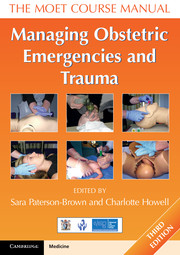Book contents
- Frontmatter
- Dedication
- Contents
- Working Group
- About the authors
- Acknowledgements
- Abbreviations
- Section 1 Introduction
- Section 2 Recognition
- Section 3 Resuscitation
- Section 4 Trauma
- Section 5 Other medical and surgical emergencies
- Section 6 Obstetric emergencies
- Section 7 Triage and transfer
- Section 8 Human issues
- 41 Human factors
- 42 Consent matters
- Index
41 - Human factors
- Frontmatter
- Dedication
- Contents
- Working Group
- About the authors
- Acknowledgements
- Abbreviations
- Section 1 Introduction
- Section 2 Recognition
- Section 3 Resuscitation
- Section 4 Trauma
- Section 5 Other medical and surgical emergencies
- Section 6 Obstetric emergencies
- Section 7 Triage and transfer
- Section 8 Human issues
- 41 Human factors
- 42 Consent matters
- Index
Summary
Objectives
On successfully completing this topic, you will be able to:
understand the concept of human error in individuals and in teams
appreciate how situation awareness and good communication can help to minimise the effects of error.
Introduction
Error is inevitable, but harm is not
(Sarah Corcoran, Associate Director of Clinical Effectiveness, Central Manchester Foundation Trust, 2009)This manual is focused on the assessment and management of the acutely ill patient. Clinicians are frequently required to utilise their knowledge and skills to care for a collapsed, or deteriorating, patient who is only one of several concurrent responsibilities.
Although the ideal of each patient being managed by a dedicated, focused, mentally and physically fit, smoothly functioning team, without interruptions or distractions, cannot be achieved, ways of working can be taught that optimise patient care.
The performance of individuals and teams working in complex, high-pressure environments is influenced by a wide range of intrinsic (personal) and extrinsic (environmental) factors. Some 20 years ago, the aviation industry began to take account of these factors, how they impact on human performance and their significance for flight safety. Today, all airline staff are required to undergo a rigorous human factors training programme that equips them with the tools to ensure that the safest option becomes the cornerstone of decision making. More recently, this has started to be adopted within health care as a means of improving safety and quality. The Department of Health recommends human factors training as a way of improving safety (CMO Report 2008, Safer Medical Practice).
- Type
- Chapter
- Information
- Managing Obstetric Emergencies and TraumaThe MOET Course Manual, pp. 469 - 480Publisher: Cambridge University PressPrint publication year: 2014

